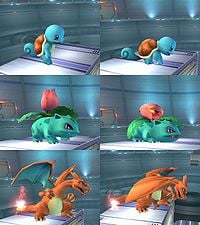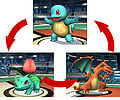Pokémon Change: Difference between revisions
m (why was this tag removed) |
(→Origin) |
||
| Line 48: | Line 48: | ||
In the Pokémon games, switching out a Pokémon retains most of its current status - it will be cured of minor status effects and stat modifications, but major status effects and HP will remain unchanged. This is in contrast to ''Brawl'', where a switched-out Pokémon regains stamina and has all status effects removed. | In the Pokémon games, switching out a Pokémon retains most of its current status - it will be cured of minor status effects and stat modifications, but major status effects and HP will remain unchanged. This is in contrast to ''Brawl'', where a switched-out Pokémon regains stamina and has all status effects removed. | ||
The concept of stamina as ''Brawl'' uses it does not exist in the Pokémon games; there is no mechanic that naturally makes a Pokémon less effective the longer it remains in play. | The concept of stamina as ''Brawl'' uses it does not exist in the Pokémon games; there is no mechanic that naturally makes a Pokémon less effective the longer it remains in play. However in the Pok�émon Anime, Pokémon that have fought for an extended period of time tend to be fatigued. | ||
==Gallery== | ==Gallery== | ||
Revision as of 23:10, May 13, 2014
| Pokémon Change | |
|---|---|
| Pokémon change Pokémon Change | |
| User | Pokémon Trainer |
| Universe | Pokémon |
| Article on Bulbapedia | Pokémon Change |
Pokémon Change (ポケモンチェンジ(共通) Pokémon Change (Common)) is Pokémon Trainer's down special move. It is one of only two moves that all three of the Trainer's Pokémon have in common (the other being Triple Finish). It switches between his three Pokémon - Charizard, Squirtle, and Ivysaur. If Charizard is currently in use, it will switch to Squirtle. If Squirtle is in use, it will switch to Ivysaur. If Ivysaur is in use, it will switch to Charizard. Using this move too little will result in the Pokémon's stamina being drained. Only one Pokémon needs be knocked out to score against Pokémon Trainer.
If one Pokémon is KO'd, Pokémon Trainer will summon the next Pokémon in the rotation to the revival platform. Pokémon Change cannot be used again until the starting invincibility has worn off. Pokémon Change also cannot be used in midair.
While changing, there is a little time in which the Pokémon have invincibility frames. It can be used to "dodge" various attacks, most notably Final Smashes.
Notably, using Pokémon Change ends nearly all status effects on the Pokémon, both positive and negative. This includes super or mini size, Starman invincibility, metal form, Franklin Badges, Screw Attacks, etc. The exceptions to this rule are slowed-time, healing in progress, and Smash Ball readiness, which remains through the change. Any held item is immediately dropped.
Like Zelda's Transform, the next Pokémon to appear must be loaded from the disc before the switch can be completed. Pausing can shorten the in-game switch time (since the game loads during the pause), as can lag when online. If the switch time is artificially shortened as such, replays will temporarily freeze at the point the switch is made (since it must take the full time to load). Forcing the game to load the next character through an SD card via hacking will result in a near-instant switch time.
A technique known as "zero switching" can be performed on horizontally moving platforms; it allows a Pokémon to switch out without while leaving the player free to react immediately after the next Pokémon is switched in. To perform the technique, the player must be standing on the edge of a platform that's opposite the direction the platform is moving (such as the right edge of the Smashville platform that's moving toward the left), and initiate Pokémon Change. If done properly, the next Pokémon will appear in the air, leaving the player free to input any aerial action. The zero switch also gives Squirtle and Ivysaur two midair jumps instead of one upon reappearance. Zero switching is commonly used to avoid the high ending lag that results from switching normally.
Stamina
Stamina is a measure of how much energy the Pokémon Trainer's Pokémon have.
At the start of a match, each Pokémon has 100 points of stamina. When a Pokémon is in battle, its stamina drops by half a point every second. (This equates to 3:20 minutes of stamina.) The Pokémon also loses half a point of stamina for every attack it attempts. Once a Pokémon's stamina drops to 40, its standing animation switches to signal fatigue. When the Pokémon's stamina reaches zero, its attacks drop in damage by a factor of 0.7x. Pokémon regain 0.8 points of stamina per second when not being used, and all Pokémon's stamina is increased by 1.3x when any one of them is KO'd.
In the Subspace Emissary, the stamina stat is removed, allowing exclusive usage of one Pokémon.
The concept of stamina is generally detrimental towards Pokémon Trainer's competitive usage. As a clear attempt at forcing players to utilize the group character's full array of options instead of sticking to one of the three Pokémon for an entire match, Pokémon Trainer mains are forced to learn three characters just to stay on top of the game, let alone take control of it, and are penalized for using a single form for too long. This is a clear contrast to other transforming characters, such as the Transform mechanic for Zelda and Sheik, which has no such penalties.
Description from the Instruction Booklet
Charizard
Call Charizard back and swap it for a different Pokémon. Damage carries over to the next Pokémon.
Squirtle
Call Squirtle back and swap it for a different Pokémon. Use a Pokémon for too long and it will tire.
Ivysaur
Call Ivysaur back and swap it for a different Pokémon. Removing a tired Pokémon from battle lets it grow strong again.
Origin
While "Pokémon Change" isn't necessarily an official term in the Pokémon universe, it does describe the act of switching a Pokémon in mid-battle. In the games it's called "switching out" and is an action that takes place before almost all other actions for that turn (the only action that can act before a switch is the move Pursuit, which is designed to counter switching). Switching Pokémon is very important in the metagame, as the benefits of bringing in an effective Pokémon against a juicy target must outweigh the risk of being hit hard, setup on, or simply outpredicted by the opponent.
In the Pokémon games, switching out a Pokémon retains most of its current status - it will be cured of minor status effects and stat modifications, but major status effects and HP will remain unchanged. This is in contrast to Brawl, where a switched-out Pokémon regains stamina and has all status effects removed.
The concept of stamina as Brawl uses it does not exist in the Pokémon games; there is no mechanic that naturally makes a Pokémon less effective the longer it remains in play. However in the Pok�émon Anime, Pokémon that have fought for an extended period of time tend to be fatigued.
Gallery
Trivia
- With precise timing, the invincibility frames during Pokémon Change can be used to avoid all three of Tabuu's Off Waves.
- Only one character can be loaded at once, so if multiple Pokémon Changes or Transforms occur at the same time, they must each wait for the previous one to complete.
- If two Pokémon Trainers are using the same palette swap through glitch or team battle, transforming into the other player's active character will be essentially instant as the data is basically already loaded.
- In Pokémon FireRed & LeafGreen, the Pokémon Trainers Poké Balls are in the his right bag pocket; however, in Pokémon Change, the Pokémon he's switching to a Poké Ball comes out the left side and the one he's calling back goes to the right.
- If Pokémon Change is used in Subspace Emissary before Ivysaur is caught, the Pokémon Trainer will just stare down at his Poké Ball.
- The Poké Balls used in the move are smaller and darker in color than the Poké Ball item, likely to prevent confusion between the two.



